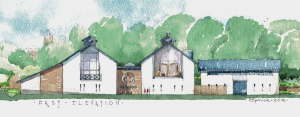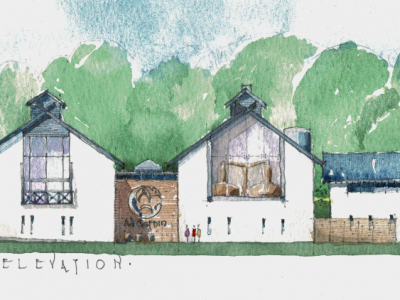Plans Submitted for Ad Gefrin Distillery
People invited to be “Spirited Away” with the plans drawn up by local Architect for Northumberland’s only Whisky Distillery.
The much anticipated plans for Wooler’s Ad Gefrin Distillery have just been submitted to Berwick Northumberland County Council for full planning permission. Featuring original hand-drawn images and elevations of the site and its buildings, they incorporate several key features that reflect the area, the local history and the significance of the Ad Gefrin name itself.

Award-winning local architect, Richard Elphick, is responsible for the designs, which draw heavily on the heritage of Glendale, on the history behind the name Ad Gefrin and on whisky production. He has chosen to base the buildings on the known details of the Anglo-Saxon palace, discovered below Yeavering Bell itself in the 1940s by aerial photography. Architectural details also reflect the traditional appearance of a Scottish distillery and that of a model farm steading.
The intention behind the building is to provide a place which fits well into the townscape of Wooler and welcomes the traveller to the town. At the same time, it will serve the important task of bringing employment to the Glendale district, as well as income from whisky production, tourism and collaborative projects.
Brinkburn based, Richard Elphick, is a celebrated local architect who is noted for his work on conservation projects. His national reputation is well-established, and he has been involved in major restorations at Wallington Hall and Cragside. Further afield, his 2016 restoration of Mount Stewart near Belfast for the National Trust received the RICS National UK Restoration Project of the Year Award.
Here Richard describes the features of his designs:
“The main core of Ad Gefrin was two large Halls set in a straight line, each 26m long, and the design for the Distillery and Visitor’s Centre reflect these large historic structures. They too will be 26m long and of similar proportions, with angular pitched roofs set side by side.”
“The proportion and shape of the buildings with their sloping pitched roofs will project the traditional appearance of old large agricultural barns, complete with narrow arrow slit vents in the walls. The bright whitewashed walls of the buildings reflect the limewashed walls of traditional distilleries and will contrast with the huge east facing glass window, which will showcase and display the 2 copper stills to the main road.

Architect, Richard Elphick
Richard explores and develops his designs from hand sketching and watercolouring to determine the most sensitive and attractive solutions for his projects. His design for the Ad Gefrin Distillery was conceived using this Arts and Crafts approach.
Additional timber cladding to walls, and screens around the buildings, will be reminiscent of the timber used in the Great Enclosures. The attractive and distinctive design will be welcoming, encouraging visitors to enter, to then be transported (dare I say spirited away??) by the visitor experience and distillery process.
“I believe the building will sit comfortably, with good manners, in the Wooler townscape, reinforcing a sense of place. The overall effect of all the buildings is intended to be rather like a planned ‘model farm’ which produces spirits.”
The search for a suitable design, and architect, involved the Ferguson family in a 2 year project, incorporating extensive travel across Canada, North America and Scotland, and the rest of the UK. Richard was chosen as the architect whose ideas best embodies the family’s vision and their Northumbrian roots and of course, the added bonus in that he is locally based.
Eileen Ferguson commented: “We are really thrilled with the plans which Richard has produced as they combine the Anglo-Saxon Hall of Ad Gefrin, and the wider historical landscape of Northumberland and Northumberland’s National Park.
From the outset, our aim was to have a multi-faceted building which would bring the history and heritage of where we love to live, and one which would attract a range of markets to provide year-round business. Richard has delivered this, and the Ad Gefrin Distillery will help in putting Wooler on the map, serving as a gateway to the town and a stopping off point for travellers.”
Ad Gefrin takes its name from the Anglo-Saxon palace below Yeavering Bell. Both names take their meaning from the “hill of the goats”, which still roam the slopes today. The site on the banks of the Glen was a place of gathering and community, and the new distillery in Wooler aims to become a similar meeting spot in the 21st Century.

